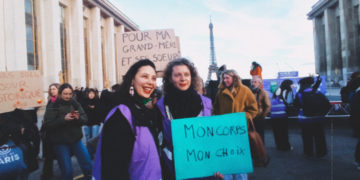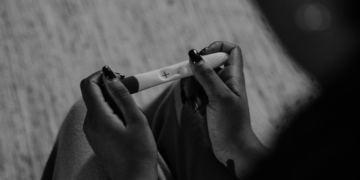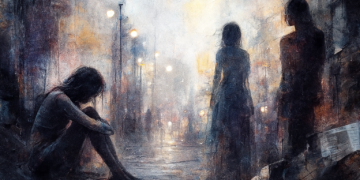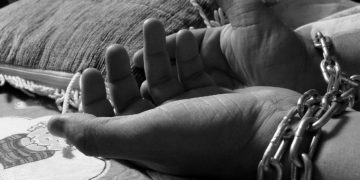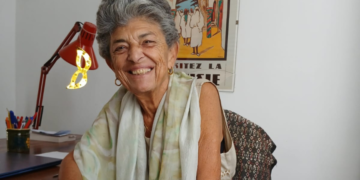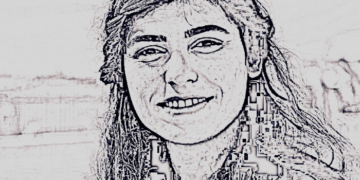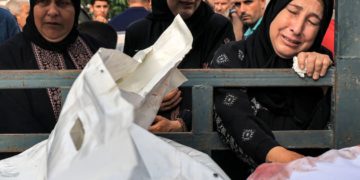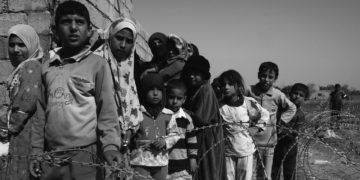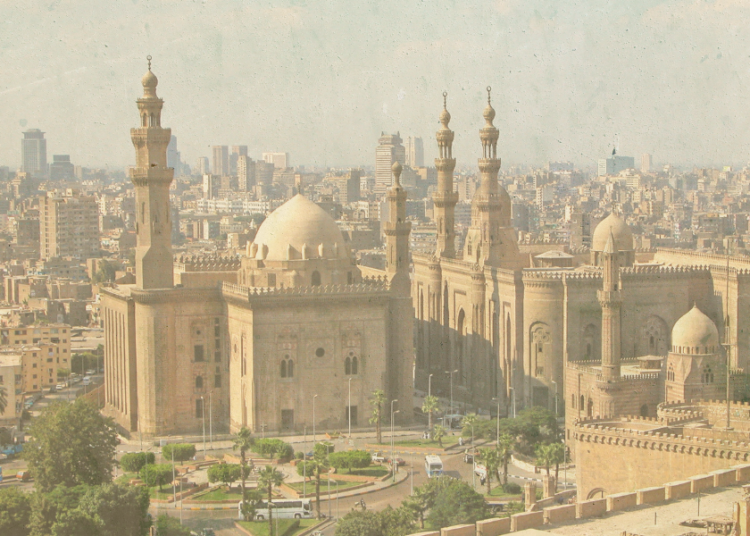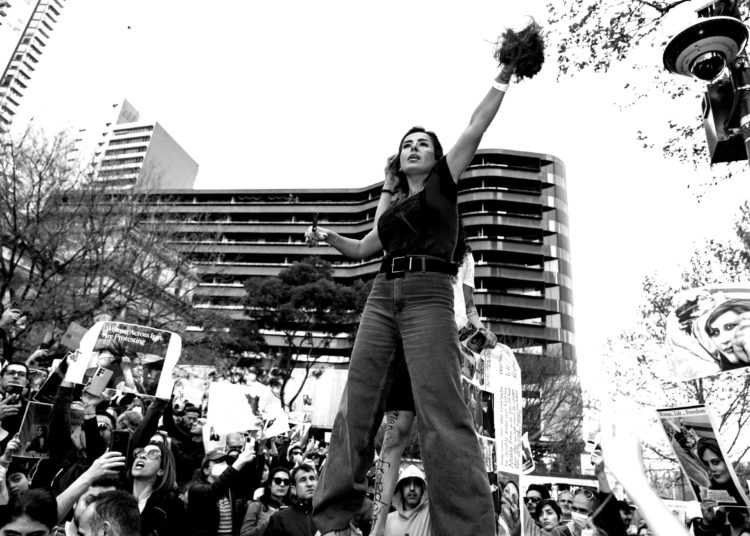This post is also available in: Français (French)
In May 2023, a hijab ceremony at an Algerian university was broadcast by Ennahar, El Bilad, and other media followed by millions of people. The ceremony took place at the University of Blida. In the video, the young women are wearing similar hijabs and carrying fans that are hiding their faces and on which the following words are written: Hidjabi soutrati (my hijab, my modesty). They are crying, regretting their past lives before they got veiled. They have crowns on their heads and are referred to as princesses, queens, guardians of purity.
On March 15 and 20, and on April 11, similar campaigns were held at the Cité universitaire d’El Alia in Algiers, the University of Khenchela, and the University of M'sila, respectively. They were widely disseminated by the conservative media—the most followed media in the country.
These ceremonies and campaigns are occurring more and more frequently in Algerian universities. They are carried out by female students who step forward to participate, as well as students and “preachers” at the heads of religious and student associations. Everything is facilitated for these ceremonies: from the availability of rooms to the influx of donations.
The process is the same. The young women who already wear the hijab start by giving talks, by taking over university residences, streets, and parks where they hand out stories to children, as well as Qurans, sweets, and flyers, preaching and encouraging women to wear the hijab. They even encourage those who are already veiled to don the wide, patternless hijab, sometimes going so far as to glorify the niqab.
These women also encourage men to make their wives put on the veil, insisting that the hijab is not a choice but a duty imposed by God, that women are even more beautiful with the veil. These campaigns have different names: in 2021, they were called Hamilat Taj El Wiqar, while today, in 2023, they’ve been dubbed Daî men yaraqi yed’ou li man rabaqi and Hidjabi Sotrati in several wilayas: Algiers, Blida, Bouira, Oran, Biskra, Ouergla, Laghouat, Ghelizane, Annaba, Constantine, Tebessa, Mostaganem, Djelfa, Mila, El-Bayadh, Gherdaïa, etc. Each wilaya is a section, and each section has its own “leader,” a “supervisor” that recruits and brings interested parties together. All you have to do is contact them on social media and explain that you are motivated to get the few women who do not cover their hair to wear the hijab. Even minors are targeted, their wearing of the veil celebrated while waiting for God to lead the other women on the right path.
The ceremonies are the same: the new recruits often wear matching uniforms, a wide hijab of the same color offered to them by the ones doing the recruiting, and a crown of flowers placed on their heads. They are given various gifts, and they all cry for joy and fear of God, repenting and calling on the other girls to also veil themselves. All these “rituals” are redundant and reveal sectarian tendencies.
This event, widely covered by the media, promises not to be the last of its kind. Behind these women are all the men silently attending the “ceremonies”—silent, but very active. The Islamists are setting their sights on taking over all universities. They want to apply the word of God. Their words and His become one. God is giving the orders, they say, when they’re the ones doing the ordering. And rejecting their injunctions becomes an opposition to God. Faced with this divine anthropomorphism, all women lose.
These campaigns promise hell to “wanton women,” to the women who walk around almost naked and who excite men. They promise hell to the fathers, to the “dayouth” brothers who do not cover up the women in their families. The hijab is characterized as a protector, shielding women from “sick” spirits.
Rejecting their injunctions becomes an opposition to God. Faced with this divine anthropomorphism, all women lose.
Here is the problem: on one hand, the veil does not protect women, and on the other, the aggressors are not sick but live up to the social norms that make women into the prey of men. There is no veil that can protect against misogyny, against rape and feminicide. Let us remind you that the veil did not protect the teachers of Bordj Badji Mokhtar from being raped[1]. It does not protect the many women who are murdered by the people they know and the people they don’t. Simply because the problem does not lie in women’s bodies; it lies in the person who decides to attack, to harasss. The problem is this culture that makes the victim feel guilty and comforts the perpetrator, that encroaches on the experience of women and adulates the desires of men, that wants to divide women by pitting them against each other: the pure, chaste women, those of paradise, distinguished by their hijab, and the impure, shameless women, those going to hell and who are taking a lot of innocent people there with them. But the real hell is this hypersexualization of our bodies which are always being exposed or hidden—which can never simply exist.
Similar campaigns have emerged in recent years, notably one in Blida that was calling for the veiling of girls between the ages of 10 and 15, or even the one that was initially launched on social media in Morocco then in Algeria: “Be a man and don’t let your wives and daughters go out in tight clothes.” This created a competition among men where the most virile was the one able to veil all his women. This campaign is not uncommon in Muslim countries, where the more women wear the hijab, the more men reveal their excessive sexual desires.
Wearing the hijab is like having a second skin—taking it off becomes a public affair, one in which everyone gets involved without even thinking about the wellbeing of the woman in question. If the hijab were truly a choice, why is this choice only available to women, not to men? In its world, Islamism abandons the notion of choice: it considers that there is no such thing as an imposed hijab, but women opposing divine will. It does not admit that there are women who are beaten and forced to veil themselves. Yet hundreds of women have testified against their forced veiling, highlighting how difficult it is to emancipate oneself from it, during the campaign entitled Les prisonnières du voile en Algérie, #سجينات_الحجاب_في_الجزائر (Prisoners of the hijab in Algeria).
These words are rarely uttered and always marginalized, but they do exist. Many women have been threatened to be expelled from school unless they wear the veil. Some have found no choice but to wear it in their neighborhoods and schools and take it off elsewhere. It is not uncommon to see prepubescent girls wearing hijabs in an attempt to get them accustomed to modesty, thus reinforcing a culture of pedophilia that views little girls as objects of desire. In this logic, the feminine must be hidden, occulted, disappeared.
The hijab is also political. The removal of women’s faces from electoral lists only to replace them with an icon of a woman wearing a veil is proof of this. The hijab imposed by law in Afghanistan, Iran, and Saudi Arabia is further illustration. Women are thus guardians of religion and tradition, while Islamist men can wear a suit and tie to show their modernity and universality.
Religious totalitarianism has borne fruit: it is no longer just the imams in mosques or on TV who preach the veil, but everyone, as everyone allows themselves to push women to cover up and punish the sinners who refuse this fabric. It is also the “influencers” with thousands or millions of followers who paint a fulfilled life by showing themselves to be respectful of tradition and religion while promoting brands making hijabs and burkinis, sometimes even luxury brands. So the hijab has become a style, a trend, a flourishing trade in our consumer societies. To please God, or to please man? The craze around the hijab creates an adverse effect: street harassers are not the least bit uncomfortable sharing their fantasies when they see women wearing the niqab. They only see one thing when it comes to women: a body to conquer, to possess.
If the hijab and women’s virginity represent the “purity” of women in society, then what about the purity of men? This notion is never discussed, simply because women bear the brunt of proving purity. Men are somehow exempt. This double standard has terrible consequences, shaping social norms and defining paradoxical mores. Lifting the veil on all this violence is essential, as no fabric in the world can protect against it.
